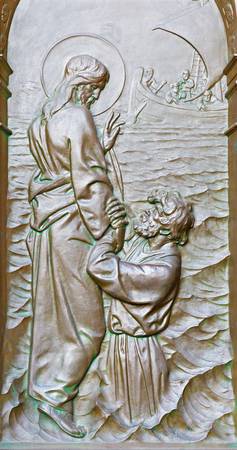
For true believers, God is more often found in art than science. You can’t see God in a formula. Our God is best appreciated in the context of our lives—like a relief sculpture carved on our hearts. Relief in the art world describes a subject that projects from and belongs to the background surface on which it is rendered. So, it’s fitting that artists have often used the relief method to depict our relationship to God. In these works God is seen in relief from the background of the lives onto which he is rendered.
This Sunday’s Mass readings show how God made lasting impressions on the lives of several people. The gospel (Mt 14:22-33) shows Him as Jesus, walking on the choppy seas and relieving his disciples of their fear. But this crew of Christians didn’t immediately recognize their captain. With the stark imagery in this passage, it’s easy to impose ourselves into Peter’s place as the Master steadies his foundering faith.
At once Jesus spoke to them, “Take courage, it is I; do not be afraid.” Peter said to him in reply, “Lord, if it is you, command me to come to you on the water.” He said, “Come.” Peter got out of the boat and began to walk on the water toward Jesus. But when he saw how strong the wind was he became frightened; and, beginning to sink, he cried out, “Lord, save me!” Immediately Jesus stretched out his hand and caught Peter, and said to him, “O you of little faith, why did you doubt?”
Maybe because God rarely presents as we expect him to. Sunday’s first reading (1 Kgs 19:9a, 11-13a) offers an image of God in sharp relief from the backgrounds we usually associate with an all-powerful Supreme Being. The prophet Elijah gives us a lesson in recognizing and appreciating the minimalist art of God.
The LORD said to him, “Go outside and stand on the mountain before the LORD; the LORD will be passing by.” A strong and heavy wind was rending the mountains and crushing rocks before the LORD—but the LORD was not in the wind. After the wind there was an earthquake—but the LORD was not in the earthquake. After the earthquake there was fire—but the LORD was not in the fire. After the fire there was a tiny whispering sound. When he heard this, Elijah hid his face in his cloak and went and stood at the entrance of the cave.
This prophet saw divinity in the peace God brought him and it strengthened him for the mission of repopulating the world with prophets. In the second reading (Rom 9:1-5) we hear Paul call out for a similar infusion of faith as he despairs that Israel can’t see the God he sees. He’s even willing to sacrifice himself if only they could appreciate the relief Jesus offers in place of the God they’re used to worshipping.
Brothers and sisters: I speak the truth in Christ, I do not lie; my conscience joins with the Holy Spirit in bearing me witness that I have great sorrow and constant anguish in my heart. For I could wish that I myself were accursed and cut off from Christ for the sake of my own people.
But God doesn’t offer that kind of relief. Instead, Paul’s eternal connection to the art of Christ has helped new generations of believers see Jesus in relation to themselves and therefore build faith that stands out in relief from this world’s ugliness. Obviously, we’re still a work in progress.
–Tom Andel